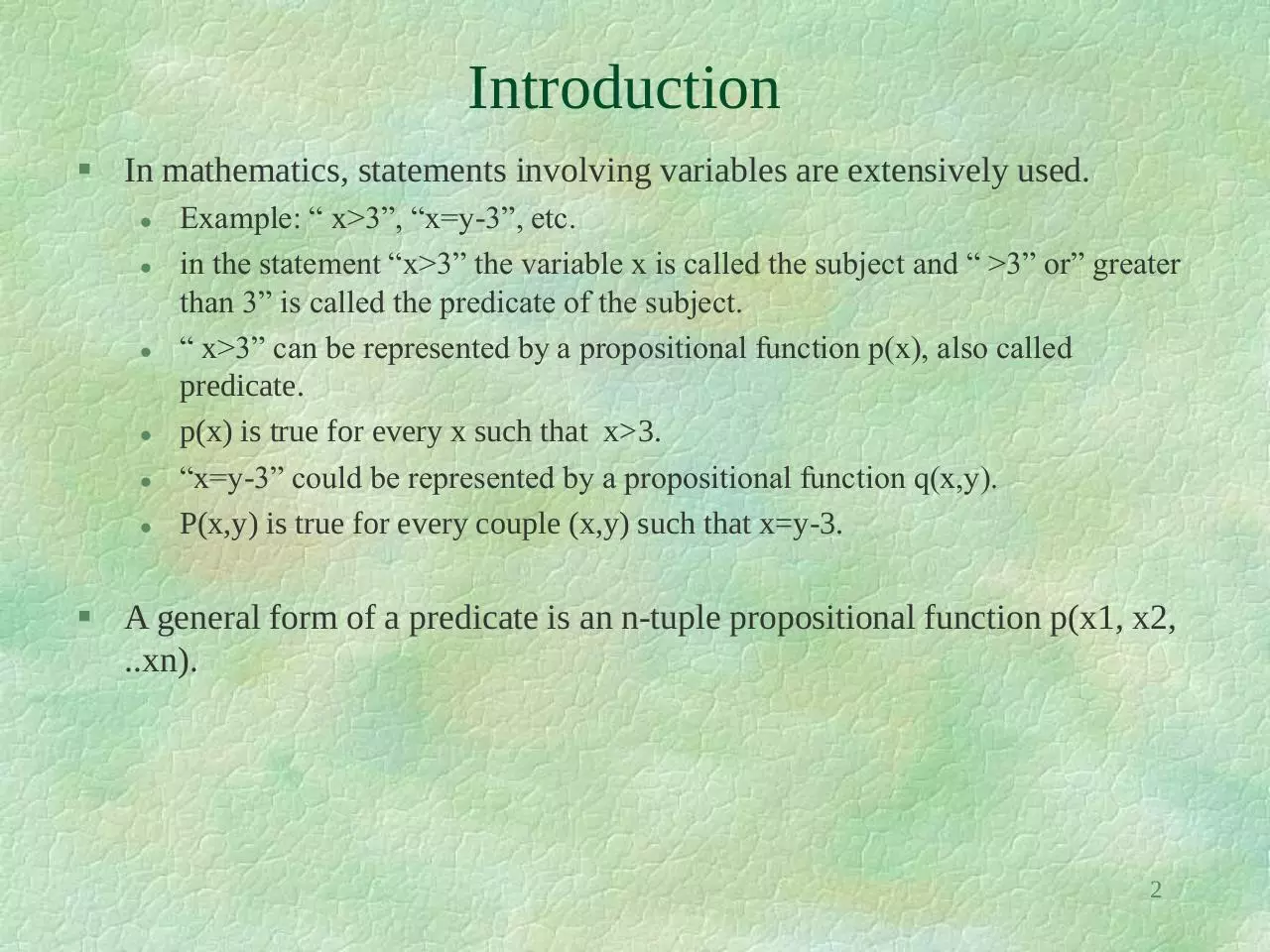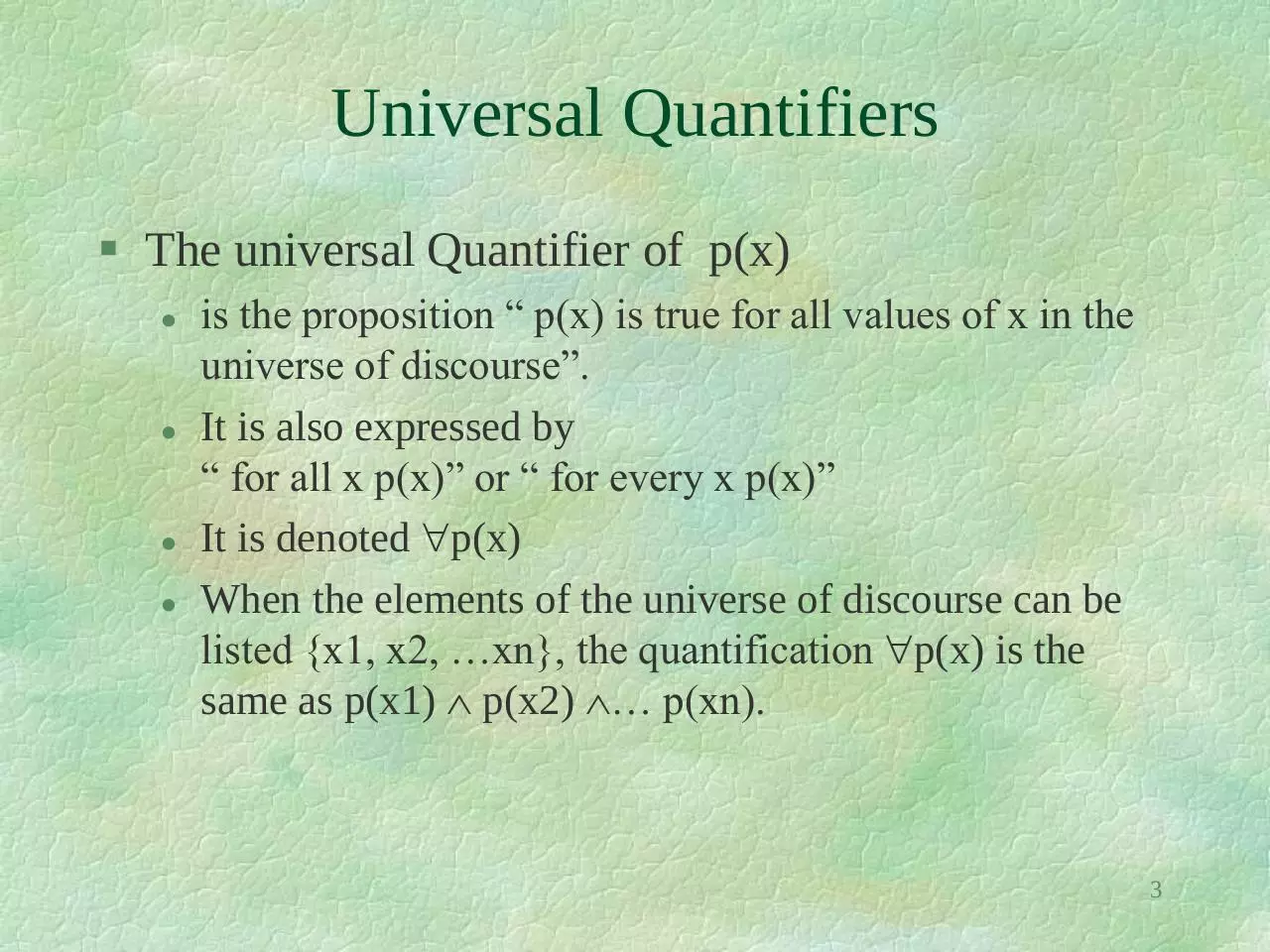Discreet lec 3 (PDF)
File information
Title: The Foundation
Author: Abdelhamid
This PDF 1.5 document has been generated by Microsoft® PowerPoint® 2013, and has been sent on pdf-archive.com on 06/11/2015 at 09:11, from IP address 41.37.x.x.
The current document download page has been viewed 636 times.
File size: 232.69 KB (10 pages).
Privacy: public file





File preview
The Foundation
Predicates and Quantifiers
1
Introduction
In mathematics, statements involving variables are extensively used.
Example: “ x>3”, “x=y-3”, etc.
in the statement “x>3” the variable x is called the subject and “ >3” or” greater
than 3” is called the predicate of the subject.
“ x>3” can be represented by a propositional function p(x), also called
predicate.
p(x) is true for every x such that x>3.
“x=y-3” could be represented by a propositional function q(x,y).
P(x,y) is true for every couple (x,y) such that x=y-3.
A general form of a predicate is an n-tuple propositional function p(x1, x2,
..xn).
2
Universal Quantifiers
The universal Quantifier of p(x)
is the proposition “ p(x) is true for all values of x in the
universe of discourse”.
It is also expressed by
“ for all x p(x)” or “ for every x p(x)”
It is denoted p(x)
When the elements of the universe of discourse can be
listed {x1, x2, …xn}, the quantification p(x) is the
same as p(x1) p(x2) … p(xn).
3
The Existential Quantifier
The existential Quantifier of p(x)
is the proposition “ There exists an element x in the
universe of discourse such that p(x) is true”.
It is also expressed by
“ There is an x such as p(x)” or “ There is at least one x
such that p(x)” or “ for some p(x).
It is denoted p(x)
When the elements of the universe of discourse can be
listed {x1, x2, …xn}, the quantification p(x) is the
same as p(x1) p(x2) … p(xn).
4
Truth Values of Quantifications
Statement
When true
When false
x p(x)
p(x) is true for every x
x p(x)
There is an x for which p(x)
is true
There is an x for
which p(x) is false.
p(x) is false for
every x.
5
Examples
All S are P : x S(x) P(x)
“All lions are fierce”
x l(x) f(x)
Some S are P : x (S(x) P(x))
“Some lions do not drink coffee”
x (l(x) d(x))
6
Examples
“ Every student in this class has studied Calculus”
If universe of discourse is students of this class -only• C(x) denotes “ x has studied calculus”
• Proposition becomes x C(x)
If universe of discourse is all student of the university
• C(x) denotes “ x has studied calculus”
• CSS(x) denotes “ x is a Computer Science student”
• the proposition becomes: x CSS(x) C(x)
Translate the statement: x(C(x) y(C(y) F(x,y)))
If universe of discourse for x and y is the set of all students in your
school.
C(x): is “ x has a computer”
F(x,y): is “ x and y are friends”
The translation:” for every student x in your school, x has a computer or
there is a student y such that y has a computer and x and y are friends”
I.e. “ every student in your school has a computer or has a friend who7
has a computer”
Examples
Translate the statements
x y z ((F(x,y) F(x,z) (y z)) F(y,z)))
• F(x,y): “ x and y are friends”
• Universe of discourse (UD) is the set of all students
“There is a student none of whose friends are also friends”
“ Everyone has exactly one best friend”
• B(x,y) :”y is the best friend of x”
x y z (B(x,y) ((z y) B(x,z))
“there is a women who has taken a flight on every airline in the
world”
• take(x,y):” x has taken y”
• isaflight(x,y): “ x is a flight on y”
x y z (take(x,z) isaflight(z,y))
8
Combining Quantifiers
A variable that is not assigned a value and no quantifier is
applied on it is said to be free otherwise it is said to be
bound.
Assume p(x,y) is “ x + y = 2”
x y p(x,y) means “for all real numbers x and real numbers y it
is true that “x + y = 2” “
False
x y p(x,y) means “there is a real number x such that for every
real number y, “ x+y=2” is true”
False
x y p(x,y) means “For every real number x, there is a number y
such that p(x,y) is true”
True
x y p(x,y) means “ there is a real number x and a real number y,
such that “x+y=2” is true “
True
9
Download Discreet lec 3
Discreet lec 3.pdf (PDF, 232.69 KB)
Download PDF
Share this file on social networks
Link to this page
Permanent link
Use the permanent link to the download page to share your document on Facebook, Twitter, LinkedIn, or directly with a contact by e-Mail, Messenger, Whatsapp, Line..
Short link
Use the short link to share your document on Twitter or by text message (SMS)
HTML Code
Copy the following HTML code to share your document on a Website or Blog
QR Code to this page

This file has been shared publicly by a user of PDF Archive.
Document ID: 0000313128.